Pemanfaatan Karbon Aktif Dari Rumput Gajah (Pennisetum purpereum) Dan Mangan Dioksida Sebagai Elektroda Superkapasitor
Utilization of Activated Carbon Derived from Elephant Grass (Pennisetum purpereum) and Manganese Dioxide as Supercapacitor Electrodes"

Date
2025Author
Marzuqi, Fathi
Advisor(s)
Frida, Erna
Humaidi, Syahrul
Metadata
Show full item recordAbstract
The growing need for sustainable and eco-friendly energy storage solutions has led to advancements in high-performance supercapacitors with extended cycle life. This research explores the fabrication of composite electrodes using activated carbon derived from elephant grass (Pennisetum purpureum) combined with manganese dioxide (MnO₂). The carbon material was produced through chemical activation with potassium hydroxide (KOH) and subsequent physical activation using carbon dioxide (CO₂). MnO₂ was incorporated into the activated carbon at various weight ratios (10:0, 07:03, 05:05, 03:07, and 0:10). Morphological and elemental analyses were performed using SEM-EDS, Meanwhile, the electrochemical performance was evaluated using galvanostatic charge-discharge (GCD) tests and electrochemical impedance spectroscopy (EIS). Of all the samples evaluated, the composite containing a 03:07 ratio of carbon to MnO₂ exhibited the highest specific capacitance, reaching 198.51 F/g, highlighting the beneficial interaction between double-layer capacitance and pseudocapacitance. These findings suggest that elephant grass-derived carbon, when effectively combined with MnO₂, presents a cost-effective and environmentally friendly option for next-generation supercapacitor electrodes.
Collections
- Master Theses [310]
